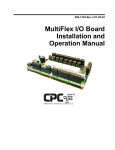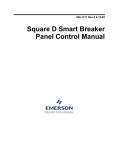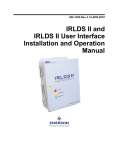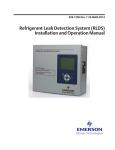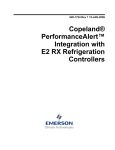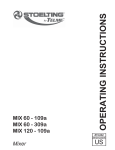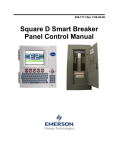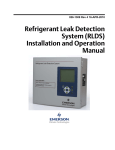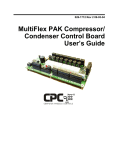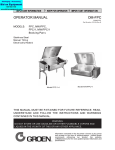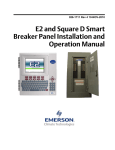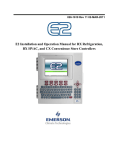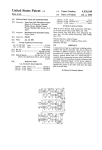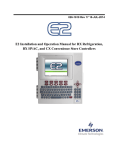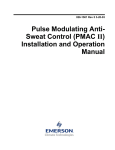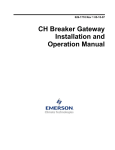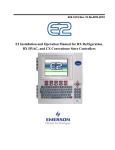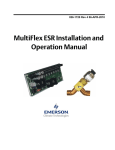Download (RF) Temperature Sensor System Installation and Operation Manual
Transcript
026-1702 Rev 5 9-17-04 VeriFresh™ Radio Frequency (RF) Temperature Sensor System Installation and Operation Manual 1640 Airport Road, Suite 104 Kennesaw, GA 31044 Phone: (770) 425-2724 Fax: (770) 425-9319 ALL RIGHTS RESERVED The information contained in this manual has been carefully checked and is believed to be accurate. However, Computer Process Controls, Inc. assumes no responsibility for any inaccuracies that may be contained herein. In no event will Computer Process Controls, Inc. be liable for any direct, indirect, special, incidental, or consequential damages resulting from any defect or omission in this manual, even if advised of the possibility of such damages. In the interest of continued product development, Com-puter Process Controls, Inc. reserves the right to make improvements to this manual, and the products described herein, at any time without notice or obligation. This product is covered under one or more of the following Computer Process Controls U.S. patents: 6360553, 6449968, 6378315, 6502409, and Alsenz U.S. patents 4612776, 4628700, and 4535602. FCC COMPLIANCE NOTICE NOTE: This equipment has been tested and found to comply with the limits for a Class B digital device, pursuant to Part 15 of the FCC Rules. These limits are designed to provide reasonable protection against harmful interference in a residential installation. This equipment generates, uses, and can radiate radio frequency energy and, if not installed and used in accordance with the instructions, may cause harmful interference to radio communications. However, there is no guarantee that interference will not occur in a particular installation. If this equipment does cause harmful interference to radio or television reception, which can be determined by turning the equipment off and on, the user is encouraged to try and correct the interference by one or more of the following measures: -- Reorient or relocate the receiving antenna -- Increase the separation between the equipment and the receiver -- Connect the equipment into an outlet on a circuit different from that to which the receiver is connected -- Consult the dealer or an experienced radio/TV technician for help Warning! FCC Regulations state that any unauthorized changes or modifications to this equipment not expressly approved by the manufacturer could void the user's authorization to operate this equipment. READ ALL INSTRUCTIONS CAREFULLY If the equipment is not used in the manner specified by the manufacturer, the protection provided by the equipment may be impaired. SAVE THIS INSTRUCTION MANUAL This instruction manual contains important operating instructions for the Verifresh RF Sensor System. European Environmental Ratings To conform with European Safety Standard EN61010-1, all VeriFresh and VeriTemp product installations must follow the following specifications: • Indoor use only • Altitude: no higher than 2000m • Operating Temperature: -40°—65°C • Relative Humidity: 5%—95% non-condensing • Installation Category II Table of Contents 1 OVERVIEW ................................................................................................................................................................... 1 1.1. HARDWARE COMPONENTS ........................................................................................................................................... 2 1.1.1. Sensors .................................................................................................................................................................. 2 1.1.1.1. VeriTemp Sensors............................................................................................................................................................... 2 1.1.1.2. Discontinued Sensor Models .............................................................................................................................................. 3 1.1.2. VeriFresh Receiver ............................................................................................................................................... 1.1.3. VeriFresh Gateway ............................................................................................................................................... 1.1.4. Hand-Held Terminal ............................................................................................................................................. 1.1.5. The RF Service Tool (US and Canada Only)........................................................................................................ 1.2. NEW VS. OLD VERIFRESH COMPATIBILITY ISSUES ...................................................................................................... 1.2.1. Dual-Thermistor Compatibility............................................................................................................................. 1.2.2. New Sensor Features ........................................................................................................................................... 1.2.3. RF Service Tool Compatibility.............................................................................................................................. 4 4 5 5 6 6 6 6 2 INSTALLING THE VERIFRESH GATEWAY......................................................................................................... 7 2.1. COMPATIBILITY WITH DUAL TEMPERATURE SENSORS ................................................................................................ 7 2.2. MOUNTING THE VERIFRESH GATEWAY ....................................................................................................................... 7 2.3. POWERING THE VERIFRESH GATEWAY ........................................................................................................................ 7 2.4. WIRING THE VERIFRESH GATEWAY TO A CPC SITE CONTROLLER (I/O NETWORK) ................................................. 8 2.4.1. Wire Connection ................................................................................................................................................... 8 2.4.2. Setting the Board Numbering Dip Switch ............................................................................................................. 8 2.4.3. Setting the Baud Rate Dip Switches...................................................................................................................... 9 2.4.4. Setting the RS485 I/O Termination Jumpers......................................................................................................... 9 2.5. NETWORKING GATEWAYS AND RECEIVERS (RECEIVER BUS NETWORK).................................................................. 10 2.5.1. Wiring the Receiver Bus Network to the Gateway.............................................................................................. 10 2.5.2. Setting the Receiver Bus Network Termination Jumpers.................................................................................... 11 2.6. CHECKING GATEWAY SETTINGS USING THE HAND-HELD TERMINAL ...................................................................... 11 2.6.1. Viewing Board Numbering and Baud Rate......................................................................................................... 11 3 INSTALLING THE VERIFRESH RECEIVER....................................................................................................... 12 3.1. COMPATIBILITY ISSUES WITH NEW VS. OLD VERIFRESH EQUIPMENT ...................................................................... 3.2. MOUNTING AND PLACEMENT OF THE VERIFRESH RECEIVER .................................................................................... 3.2.1. Environmental Operating Conditions................................................................................................................. 3.2.2. Placement............................................................................................................................................................ 3.2.3. Mounting ............................................................................................................................................................. 3.3. POWERING THE VERIFRESH RECEIVER....................................................................................................................... 3.3.1. Powering the 418MHZ (US & Canada) Receivers............................................................................................ 3.3.2. Powering the 433MHz (UK & Australia) Receivers........................................................................................... 3.4. WIRING THE VERIFRESH RECEIVER TO A CPC SITE CONTROLLER ........................................................................... 3.4.1. Wire Connection ................................................................................................................................................. 3.4.2. Setting the Receiver Bus Network Termination Jumpers.................................................................................... 3.4.3. Setting the Receiver Numbering Dip Switch ....................................................................................................... 3.4.4. Setting the Baud Rate Dip Switch ....................................................................................................................... 12 12 12 12 12 12 12 13 13 13 14 14 14 4 INSTALLING THE VERITEMP SENSOR.............................................................................................................. 16 4.1. PLACEMENT OF VERITEMP SENSORS ......................................................................................................................... 4.1.1. Line-of-Sight........................................................................................................................................................ 4.1.2. Orientation .......................................................................................................................................................... 4.2. MOUNTING VERITEMP/VERIFRESH SENSORS ............................................................................................................ 16 16 16 17 Table of Contents • vii 4.2.1. Right-Angle Mounting Kit (P/N 603-0100)......................................................................................................... 17 4.2.2. Wire Shelf Mounting Kit (P/N 603-0101) ........................................................................................................... 18 4.2.3. Thin Shelf Mounting Kit (P/N 603-0102)............................................................................................................ 18 4.3. ACTIVATION................................................................................................................................................................ 18 4.3.1. Verifying Active State .......................................................................................................................................... 19 4.4. DIGITAL INPUT WIRING .............................................................................................................................................. 19 5 COMMISSIONING THE VERITEMP SENSORS .................................................................................................. 20 5.1. WHAT IS COMMISSIONING? ........................................................................................................................................ 20 5.2. MANUAL ENTRY METHOD.......................................................................................................................................... 21 5.2.1. Entering the ID Numbers on the VeriFresh Gateway ......................................................................................... 21 5.3. SERVICE BUTTON METHOD ........................................................................................................................................ 22 5.3.1. Setting up the VeriFresh Gateway to Receive ID Transmissions........................................................................ 22 5.3.2. Hand-Held Terminal Screen Navigation Tips..................................................................................................... 24 5.4. VERIFYING SUCCESSFUL COMMISSIONING ................................................................................................................. 24 5.5. DECOMMISSIONING A SENSOR FROM THE VERIFRESH GATEWAY ............................................................................. 24 5.5.1. Decommissioning Manually Entered ID Numbers.............................................................................................. 24 5.5.2. Decommissioning ID Numbers Entered By Service Button ................................................................................ 24 5.6. SETTING THE SENSOR FAILURE TIMEOUT .................................................................................................................. 25 6 CONNECTING SENSORS TO E2/EINSTEIN/REFLECS..................................................................................... 26 6.1. THE LOW BATTERY SIGNAL ....................................................................................................................................... 26 7 OPERATION AND MAINTENANCE OF THE VERITEMP SENSOR SYSTEM ............................................. 27 7.1. STATUS LEDS ............................................................................................................................................................. 27 7.1.1. VeriTemp Sensors................................................................................................................................................ 27 7.1.2. VeriFresh Receivers ............................................................................................................................................ 27 7.1.2.1. The Status LED................................................................................................................................................................. 27 7.1.2.2. The RF LED...................................................................................................................................................................... 27 7.1.2.3. The Receiver Bus LED ..................................................................................................................................................... 27 7.1.3. VeriFresh Gateway ............................................................................................................................................. 28 7.1.3.1. 7.1.3.2. 7.1.3.3. 7.1.3.4. The General Status LED ................................................................................................................................................... The Alarm LED ................................................................................................................................................................ RS485 I/O Network Status LED....................................................................................................................................... Receiver Bus Network Status LED................................................................................................................................... 28 28 28 28 7.2. BATTERY LIFE AND REPLACEMENT............................................................................................................................ 28 7.2.1. Reactivating the VeriTemp Sensor ...................................................................................................................... 29 7.3. VIEWING STATUS USING THE HAND-HELD TERMINAL .............................................................................................. 29 7.3.1. Viewing Update Counts....................................................................................................................................... 30 7.3.1.1. Resetting the Sensor Update Count .................................................................................................................................. 30 7.4. VERITEMP SENSOR SLEEP MODE ............................................................................................................................... 31 APPENDIX B: SENSOR PLACEMENT GUIDELINES........................................................................................... 35 GENERAL MOUNTING AND PLACEMENT GUIDELINES ...................................................................................................... 35 • SENSOR AND TRANSMITTER MOUNTING GUIDELINES .................................................................................................... 35 • RECEIVER MOUNTING AND PLACEMENT GUIDELINES .................................................................................................... 36 APPENDIX C: TROUBLESHOOTING GUIDELINES............................................................................................ 37 viii • VeriFresh RF Sensor System I&O Manual 026-1702 Rev 5 9-17-04 1 Overview multiple temperature sensors from the cases back to the site controllers. All sensors in the VeriFresh family are completely wireless, transmitting their values to receivers in the store area that pass them back to the site controllers. CPC’s VeriFresh Radio Frequency (RF) Temperature Sensor System provides refrigerated case temperature monitoring and control without the time and expense required to wire DAIRY BEER OF RE CE PT IO N VeriFresh Receiver VeriFresh Receiver PRODUCE MEAT RA DI US FROZEN FOOD = VeriFresh Product Simulator STORE FLOOR RF GATEWAY RF GATEWAY 16AI 16AI 16AI 8RO 8RO RS485 NETWORK RF GATEWAY RS485 NETWORK RS485 NETWORK = VeriTemp Sensor 8RO SITE CONTROLLERS (E2/EINSTEIN OR REFLECS) Figure 1-1 - VeriFresh System Diagram Overview • 1 1.1. Hardware Components 1.1.1. Sensors 1.1.1.1. VeriTemp Sensors Sensors for US and Canada Part Number Case Color/ Wire Color 809-3550 White 809-3551 Black 809-3552 White 809-3553 Black 809-3554 White 809-3555 Black 809-3558 White 809-3559 Black Figure 1-2 - Ambient Temperature Sensor (809-3542, 809-3544 pictured) The VeriTemp Sensor is an enclosure with a built-in broadcast antenna. This sensor may be mounted anywhere within a refrigerated case, as long as it is within 150 feet of a VeriFresh Receiver and within a clear line-of-sight to the receiver’s antenna. 16 models of the VeriTemp Sensor are available. Each model has either internal or external temperature sensing elements, and with or without external general-purpose digital inputs. Models are also available with two temperature sensor inputs, allowing control or monitoring of two cases with a single VeriTemp transmitter. Table 1-1 lists all VeriTemp Ambient Temperature Sensor models along with their characteristics for US and Canada only (418 MHz), and Table 1-2 lists all VeriTemp Ambient Temperature Sensor models along with their characteristics for Europe, Australia, and New Zealand (433 MHz). 2 • VeriFresh RF Sensor System I&O Manual Description VeriTemp Transmitter with External NSF-Approved Sensor and Digital Input 418MHz, with external NSF-Approved stainless steel bullet sensor connected to 20’ neoprene leads, also with a second pair of 20’ neoprene external leads for connection to digital input. VeriTemp Sensor with Internal NSF-Approved Sensor and Digital Defrost Input 418MHz, with sensor element mounted inside enclosure and external leads for connection to digital input. VeriTemp Transmitter with External Thermistor Connector and Digital Defrost Input 418MHz, with Molex connector for connection to an external temperature sensor (purchased separately) and 20’ NSFapproved neoprene leads for connection to digital input. VeriTemp Transmitter with Dual Thermistor Connectors, 418MHz, with two Molex connectors for connection to external temperature sensors (purchased separately). Table 1-1 - VeriTemp Sensor Models for US and Canada 026-1702 Rev 5 9-17-04 Sensors for Europe, Australia, and NZ Part Number Color 809-3650 White 809-3651 Black 809-3652 White 809-3653 Black 809-3654 White 809-3655 Black 809-3658 White 809-3659 Black Sensor Description VeriTemp Transmitter with External NSF-Approved Sensor and Digital Input 433MHz, with external NSF-Approved stainless steel bullet sensor connected to 20’ neoprene leads, also with a second pair of 20’ neoprene external leads for connection to digital input. VeriTemp Sensor with Internal NSF-Approved Sensor and Digital Defrost Input 433MHz, with sensor element mounted inside enclosure and external leads for connection to digital input. VeriTemp Transmitter with External Thermistor Connector and Digital Defrost Input 433MHz, with Molex connector for connection to an external temperature sensor (purchased separately) and 20’ NSFapproved neoprene leads for connection to digital input. VeriTemp Transmitter with Dual Thermistor Connectors, 433MHz, with two Molex connectors for connection to external temperature sensors (purchased separately). Table 1-2 - VeriTemp Sensor Models for Europe, Australia, NZ 1.1.1.2. Discontinued Sensor Models Table 1-3 lists models of VeriTemp and VeriFresh sensors that are no longer available for order from CPC. These sensors are still fully compatible with the CPC VeriFresh RF Temperature Sensor system, and do not require field replacement in a retrofit of new VeriFresh RF Receivers and RF Gateways. Hardware Components Discontinued Products Part Number Color 809-3548 White 809-3549 Black 809-3648 White 809-3649 Black 809-3542 White 809-3543 Black 809-3544 White 809-3545 Black 809-3556 White 809-3557 Black 809-3642 White 809-3643 Black 809-3644 White 809-3645 Black 809-3656 White 809-3657 Black Description RF Product Simulator 418MHz RF Product Simulator 433MHz VeriTemp Sensor with Internal Thermistor 418 MHz, with internal clean switch. VeriTemp Transmitter with External Thermistor on 20’ NSF-approved leads 418 MHz, with 20’ NSF-approved neoprene leads for external clean switch. VeriTemp Transmitter with Molex Connector for External Thermistor 418 MHz, with 20’ NSF-approved neoprene leads for external clean switch. VeriTemp Sensor with Internal Thermistor 433 MHz, with internal clean switch. VeriTemp Transmitter with External Thermistor on 20’ NSF-approved leads 433 MHz, with 20’ NSF-approved neoprene leads for external clean switch. VeriTemp Transmitter with Molex Connector for External Thermistor 433 MHz, with 20’ NSF-approved neoprene leads for external clean switch. Table 1-3 - Discontinued VeriTemp Sensor Models Overview • 3 1.1.2. VeriFresh Receiver 1.1.3. VeriFresh Gateway Figure 1-3 - VeriFresh Receiver The VeriFresh Receiver is an antenna that mounts to the ceiling of the sales area or on top of a refrigerated case. The VeriFresh Receiver accepts transmissions from VeriTemp Sensors and VeriFresh Product Simulators. It passes the sensor readings it receives to the VeriFresh Gateway by way of an RS485 network connection. Up to six VeriFresh Receivers may be mounted within a single building. VeriFresh Receiver Models Part Number Color 809-3510 White 809-3510 Black 809-3610 White 809-3610 Black Description VeriFresh Receiver, white casing, 418MHz. VeriFresh Receiver, black casing, 433MHz 4 • VeriFresh RF Sensor System I&O Manual Figure 1-4 - VeriFresh Gateway Board The VeriFresh Gateway (P/N 810-3500) is an RS485 peripheral board compatible with E2, Einstein, and REFLECS (RMCC, BEC, and BCU) systems. The VeriFresh Gateway serves as an interface between the VeriFresh Receivers, which send messages from the sensors and the site controllers, which use the sensor values for logging, controlling, and alarming. Each E2, Einstein, or REFLECS controller that will read values from VeriTemp Sensors must be equipped with a VeriFresh Gateway. Sensors and product simulators that will be used by an E2 or Einstein must be “commissioned” in the VeriFresh Gateway’s software. Once a sensor is commissioned, the gateway then assigns the sensor to a virtual “board and point” address. This allows the site controller to tie application inputs to VeriTemp Sensor values in the same way traditional 16AI board and point inputs are set up. 026-1702 Rev 5 9-17-04 1.1.4. Hand-Held Terminal 1.1.5. The RF Service Tool (US and Canada Only) Figure 1-5 - Hand-Held Terminal (HHT) The Hand-Held Terminal (HHT) (P/N 8113110), shown in Figure 1-5, connects directly to the RJ11 jack on a VeriFresh Gateway and is used to commission VeriTemp Sensors and view the status of the system. Figure 1-6 - The RF Service Tool The RF Service Tool (P/N 811-1000) is an installation aid and troubleshooting tool for service and installation technicians. For testing VeriTemp sensors and VeriFresh Product Simulators, the RF Service Tool has a receiver antenna and a display mode that shows analog and digital values. For troubleshooting the RS485 and Receiver Bus networks, the RF Service Tool can be wired in-line with your networks and detect wiring or equipment problems or “listen” to network traffic. More information about the functions of the RF Service Tool is available in the RF Service Tool Operator’s Guide, P/N 026-1703. Hardware Components Overview • 5 Low Battery Notification 1.2. New vs. Old VeriFresh Compatibility Issues In 2004, CPC updated the design of all VeriFresh sensors, VeriFresh Receivers, and the VeriFresh Gateway. For the most part, all new VeriFresh designs are functionally compatible with previous versions of VeriFresh equipment, but there are some exceptions, as well as new features in the new products that will not work with older-style hardware. 1.2.1. Dual-Thermistor Compatibility The dual-thermistor VeriFresh sensors (8093558, 809-3559, 809-3658, and 809-3659) are not compatible with old-style VeriFresh Receivers or VeriFresh Gateways. If you are installing a dual-thermistor VeriFresh sensor in a site where existing VeriFresh hardware is installed: • • Verify the logo sticker on the top of the VeriFresh Receiver enclosure is a domed plastic label with the VeriFresh logo in blue lettering. This indicates the VeriFresh Receiver is the new version and is capable of communicating with the dual-thermistor sensors. If any VeriFresh Receivers in the store have a flat plastic label with a green logo, they must be replaced with new VeriFresh receivers. Verify the VeriFresh Gateway is version 1.30 or greater. Any Gateway before version 1.30 is not compatible with dual-thermistor sensors. The version number of the Gateway can be determined by plugging a Hand-Held Terminal into the HHT port and reading the version number on the opening screen. A VeriTemp sensor will send a signal to indicate its battery is low. This signal may be read by a VeriFresh Gateway and passed along to the site controller as a digital input. This features can only be used if the VeriFresh Gateway is version 1.30 or greater. Any Gateway version below 1.30 must be upgraded or replaced if you wish to use low battery notification. Version Number Display Sensors that are version 2.0 or greater will send the VeriFresh Gateway its version number during the commissioning process. This will be read by the Gateway and is displayed in the sensor’s information screen in the Gateway’s HandHeld Terminal interface. Sensor version numbers can be read only be used if all VeriFresh Receivers are the new style receivers (i.e. a blue logo with a domed plastic label on the top of the enclosure) and if the VeriFresh Gateway is version 1.30 or greater. If one or more VeriFresh receivers are the old style receivers (flat label with green logo), they will need to be replaced with new receivers to take advantage of the low battery and version number capabilities. Likewise, any Gateway version below 1.30 must be upgraded or replaced. 1.2.3. RF Service Tool Compatibility The RF Service Tool must be version 2.0 firmware or greater if you wish to read dualthermistor VeriTemp sensors. Also, only the version 2.0 or greater RF Service Tools are capable of reading and displaying the version number of a VeriTemp sensor. 1.2.2. New Sensor Features All VeriTemp sensors versions 2.0 or greater have new features not present in older version sensors. They are: 6 • VeriFresh RF Sensor System I&O Manual 026-1702 Rev 5 9-17-04 2 Installing the VeriFresh Gateway Installing the VeriFresh Gateway device for a site controller involves mounting and powering the device, connecting to the CPC controller’s RS485 network, and networking the VeriFresh Gateway with other gateways and receivers on-site. 2.1. Compatibility with Dual Temperature Sensors In order to support the new dual temperature sensors (809-3558, 809-3559, 809-3658, or 8093659), the VeriFresh Gateway firmware was updated. If you are using these sensors, your VeriFresh Gateway must be version 1.30 or higher. To check the version number, plug a handheld terminal into the HHT port while the Gateway is powered up. The version number will be visible on the opening screen. Figure 2-1 - VeriFresh Gateway Board Mounting Dimensions The VeriFresh Gateway should be mounted in an environment with ambient temperature between -40°F and 150°F, with a non-condensing relative humidity between 5% and 95%. 2.3. Powering the VeriFresh Gateway Input Voltage 24VAC, Class 2, 50/60Hz Power 5VA Table 2-1 - VeriFresh Gateway Power Requirements 2.2. Mounting the VeriFresh Gateway The VeriFresh Gateway is typically mounted in the same area as the site controller, near the controller’s 16AI, 8RO, and other RS485 network peripherals. The VeriFresh Gateway is designed to fit into a standard 3" snap track (supplied with the board) or may be mounted in a panel or on stand-offs. Follow the dimensions in Figure 2-1 for panel mounting. The VeriFresh Gateway requires 24VAC power from a Class 2 center-tapped transformer. CPC supplies several sizes of center-tapped transformers for powering multiple 16AIs, 8ROs, and other RS485 peripheral boards of the E2, Einstein, and REFLECS systems. Refer to your controller’s user manual for information on how to use the center-tapped transformers listed in Table 2-1 to power multiple RS485 I/O devices for the US and Canada. NOTE: European, Australian, and New Zealander customers must purchase their own transformers. The Transformer must be 9VDC with a positive center pin and negative shield. Compatibility with Dual Temperature Sensors Installing the VeriFresh Gateway • 7 Figure 2-1 shows how to connect the 56VA and 80VA transformers to the VeriFresh Gateway power connector. Three-Board P/N Power Rating Six-Board 640-0056 640-0080 56 VA 80 VA Table 2-1-US and Canada Power Ratings for CPC Transformers 2.4.1. Wire Connection Using shielded three-conductor network cable (Belden #8641 or equivalent), connect the RS485 I/O Network wire to the three-terminal connector on the VeriFresh Gateway board as shown in Figure 2-2. For further information about how RS485 networks are configured, refer to your site controller’s user manual. Figure 2-2 - Connecting the VeriFresh Gateway to the RS485 Network Figure 2-1 - Pinout for the 56VA (640-0056) and 80VA (6400080) Transformers 2.4. Wiring the VeriFresh Gateway to a CPC Site Controller (I/O Network) Each E2, Einstein, or REFLECS site controller that will receive a temperature value from a VeriTemp Sensor must have a VeriFresh Gateway installed on its RS485 I/O Network. For E2 and Einstein controllers, this means the VeriFresh Gateway will be installed on the I/O Network; for RMCC, BEC, BCU, and other REFLECS products, the VeriFresh Gateway will be installed on the COM A or COM D network. 8 • VeriFresh RF Sensor System I&O Manual 2.4.2. Setting the Board Numbering Dip Switch The E2, Einstein, or REFLECS controller interprets the VeriFresh Gateway board as a series of four 16AI Analog Input boards numbered in succession. Addressing the “boards” represented by the VeriFresh Gateway is achieved by setting dip switches 1 through 4 to the first board number to be used. When this number is set, the VeriFresh Gateway will also use the next three board numbers above the first board number. For example, if a VeriFresh Gateway dip switch is set to board number 3, the VeriFresh Gateway will use board numbers 3, 4, 5, and 6 on the I/O Network. Note that because the VeriFresh Gateway reserves four 16AI Board numbers for its own use, an I/O network with a VeriFresh Gateway is limited to 12 16AI boards. Note also that since 16 is the highest board number possible, a VeriFresh Gateway’s dip switch may not be set to any number above 13. 026-1702 Rev 5 9-17-04 Figure 2-3 - VeriFresh Gateway Dip Switch Numbering 2.4.3. Setting the Baud Rate Dip Switches Dip switches 6 and 7 control the baud rate at which the VeriFresh Gateway communicates with the site controller on the RS485 Network. These switches must be set to the same baud rate setting as the E2, Einstein, or REFLECS (usually 9600 baud). Dip switch 8 controls the baud rate at which the VeriFresh Gateway communicates with the other devices on the Receiver Bus Network. This baud rate may only be set to either 9600 baud (switch DOWN) or 19200 baud (switch UP). All VeriFresh Gateways and VeriFresh Receivers on the Receiver Bus Network must have the same baud rate dip switch setting. It is recommended you use 9600 baud as the Receiver Bus Network baud rate. Figure 2-4 - Dip Switch Setting for Numbering VeriFresh Gateway 2.4.4. Setting the RS485 I/O Termination Jumpers As part of a site controller’s RS485 I/O (COM A or COM D) Network, a VeriFresh Gateway must be terminated if it is the end device of a daisy chain. Refer to the controller’s user manual for information about daisy chain networks and how they are terminated. To terminate the VeriFresh Gateway, set the I/O Network Jumpers to the RIGHT position as shown in Figure 2-5. To unterminate the VeriFresh Gateway, set the jumpers to the LEFT position. Wiring the VeriFresh Gateway to a CPC Site Controller (I/O Network) Installing the VeriFresh Gateway • 9 Figure 2-5 - VeriFresh Gateway RS485 I/O Network Termination 2.5. Networking Gateways and Receivers (Receiver Bus Network) The RS485 Receiver Bus Network interconnects all VeriFresh Gateways and Receivers on the site. Like the RS485 I/O Networks that interconnect the site controllers, input boards, output boards, and VeriFresh Gateways, the Receiver Bus Network must be set up in a daisy chain configuration. All devices must be wired together in a single chain as shown in Figure 26, with no branches and with no device connected to more than two other devices. Figure 2-6 - Daisy Chain Configuration - Receiver Bus Network 2.5.1. Wiring the Receiver Bus Network to the Gateway Using shielded three-conductor cable (Belden #8641 or equivalent), wire the VeriFresh Gateway to the Receiver Bus Network as shown in Figure 2-7. Figure 2-7 - Receiver Bus Network Wiring 10 • VeriFresh RF Sensor System I&O Manual 026-1702 Rev 5 9-17-04 2.5.2. Setting the Receiver Bus Network Termination Jumpers As shown in Figure 2-6, the Receiver Bus daisy chain must be terminated at the two devices at the end of the chain. The location of the termination jumpers on the VeriFresh Gateway are shown in Figure 2-8. To terminate a VeriFresh Gateway, set the jumpers to the RIGHT position. To unterminate the VeriFresh Gateway, set the jumpers to the LEFT position. The opening screen will display the part number and version of the Gateway firmware. The last line of the opening screen will display any alarm conditions pertaining to Gateway operation. 2.6.1. Viewing Board Numbering and Baud Rate From the opening screen, pressing the DOWN ARROW key once will display a screen showing the 16AI board numbering and network baud rates set for this Gateway. 16AI: 1 TO 4 I/O BAUD: 9600 RCV BAUD: 9600 TIMEOUT-MIN: 60 The top line shows the 16AI board numbers represented by this Gateway on the site controller’s I/O network. These numbers are determined by setting of the network address dip switch, and are not changeable from this screen. Figure 2-8 - RS485 Receiver Bus Network Termination 2.6. Checking Gateway Settings Using the HandHeld Terminal When the VeriFresh Gateway is powered and networked with both the site controller and the VeriFresh Receiver(s), you may check the status of the Gateway with the Hand-Held Terminal (HHT). Plug the Hand-Held Terminal into the HHT jack on the VeriFresh Gateway. The HHT should power up and display the opening screen. The second and third line show the baud rate settings for the I/O network and the Receiver Bus network. These values are also set by the dip switches, and are not changeable from this screen. The last line sets the minimum amount of time a RF sensor must fail to report a value before the VeriFresh Gateway considers the sensor failed (and generates an alarm). This parameter may be changed with the HHT. Press the RIGHT ARROW to move the cursor to the TIMEOUT-MIN parameter, and enter a value from 20 to 999 minutes. Press the DOWN ARROW key to save your changes. CPC - RF GATEWAY 810-3500 VER: 1.30F01-01 FAIL: USER CFG Checking Gateway Settings Using the Hand-Held Terminal Installing the VeriFresh Gateway • 11 3 Installing the VeriFresh Receiver Installing a VeriFresh Receiver requires mounting the receiver, powering the receiver, and networking the receiver together with other receivers and gateways on the RS485 Receiver Bus Network. 3.1. Compatibility Issues With New vs. Old VeriFresh Equipment 3.2.2. Placement The VeriFresh Receiver must be placed above the sales floor within 150 feet of the sensors it will receive transmissions from. Each VeriTemp Sensor in the store must be no more than 150 feet from a VeriFresh Receiver, so for installations that require multiple receivers, make sure each VeriFresh Receiver is placed so that all VeriTemp Sensors have a receiver within the maximum distance. 3.2.3. Mounting The VeriFresh Receiver currently sold by CPC, which features the VeriFresh logo in blue lettering with a plastic dome label, has a different hardware and firmware design that allows it to communicate with the new VeriTemp dual temperature sensors (809-3558, 809-3559, 8093658, 809-3659). The receiver may be mounted either against the ceiling (with the antenna pointing toward the floor) or on top of a case (with the antenna pointing directly toward the ceiling). Alternately, the receiver may be mounted sideways (e.g., on a riser or a wall), but this will limit the range of reception to only those VeriTemp Sensors that are within the 180° arc of the direction the antenna is pointing (i.e., it may not pick up sensors located behind the receiver base). Older versions of the VeriFresh Receiver, which feature a flat label with the VeriFresh logo in green, are not compatible with the VeriTemp dual temperature sensors. Note the status LEDs and wire connections are located on the bottom of the receiver enclosure; try to mount the receiver so that these connections are accessible. If you are installing dual temperature sensors in a site with the old-version VeriFresh Receiver (with the green label), you will need to replace all VeriFresh receivers with new VeriFresh Receivers with the domed blue label. 3.2. Mounting and Placement of the VeriFresh Receiver 3.2.1. Environmental Operating Conditions The VeriFresh Receiver should be mounted in an environment with ambient temperature between 30°F and 120°F, with a non-condensing relative humidity between 5% and 95%. 12 • VeriFresh RF Sensor System I&O Manual 3.3. Powering the VeriFresh Receiver 3.3.1. Powering the 418MHZ (US & Canada) Receivers. The VeriFresh Receiver models for the US & Canada (809-3510 and 809-3511) require a 9VDC power source. A 110VAC to 9VDC transformer is supplied with the VeriFresh Receiver. Plug the adapter into the receiver base, and connect the transformer to a 110VAC line. 026-1702 Rev 5 9-17-04 3.3.2. Powering the 433MHz (UK & Australia) Receivers The VeriFresh Receiver models for the UK & Australia (809-3610 and 809-3611) are not supplied by CPC with supply transformers. Customers purchasing these receivers must obtain a 9VDC center-pin positive transformer rated for 200mA or greater. 3.4.1. Wire Connection Connect the Receiver Bus Network wire to the three-terminal connector on the VeriFresh Receiver board as shown in Figure 3-2. Figure 3-1 shows the dimensions the power supply connector must conform to when selecting a transformer. Figure 3-1 3.4. Wiring the VeriFresh Receiver to a CPC Site Controller Each VeriFresh Receiver passes along sensor values it receives to a VeriFresh Gateway on its RS485 Receiver Bus Network. Figure 3-2 - Connecting the VeriFresh Receiver to the RS485 Network Wiring the VeriFresh Receiver to a CPC Site Controller Installing the VeriFresh Receiver • 13 3.4.2. Setting the Receiver Bus Network Termination Jumpers To assign a VeriFresh Receiver a number on the VeriFresh Gateway network, set switches 15 to the desired number. See Figure 3-4. The devices at each end of the Receiver Bus Network daisy chain must be terminated. To terminate the Receiver Bus Network at the VeriFresh Receiver, set the jumpers to the UP position, as shown in Figure 3-3. To unterminate the VeriFresh Gateway, set the jumpers to the DOWN position. Figure 3-4 - Dip Switch Setting for Numbering VeriFresh Receiver 3.4.4. Setting the Baud Rate Dip Switch Figure 3-3 - VeriFresh Receiver Receiver Bus Termination Settings 3.4.3. Setting the Receiver Numbering Dip Switch The VeriFresh Receiver must be identified with a unique number on the VeriFresh Gateway network. This allows VeriFresh Gateways to determine the source of incoming temperature readings. VeriFresh Receivers must be numbered sequentially, starting with #1 and continuing to the maximum number of receivers allowed (currently 6). 14 • VeriFresh RF Sensor System I&O Manual Dip switches 6 and 7 control the baud rate at which the VeriFresh Receiver communicates with the site controller on the Receiver Bus Network. These switches should be set to the same position as all other Receiver Bus Network devices so they will communicate at the same baud rate. It is recommended the baud rate be set at 9600 baud for all Receiver Bus devices. 026-1702 Rev 5 9-17-04 Figure 3-5 - Dip Switch Setting for VeriFresh Receiver Baud Rate Wiring the VeriFresh Receiver to a CPC Site Controller Installing the VeriFresh Receiver • 15 4 Installing the VeriTemp Sensor Figure 4-1 demonstrates a few examples of difficult sensor placements and some ideas on how to provide a clear line-of-sight. This section details how to install the various models of VeriTemp Sensors, including mounting and placement, activation, and clean switch and defrost termination wiring. 4.1. Placement of VeriTemp Sensors Ideally, all VeriTemp Sensor models should be located somewhere within a refrigerated case where a clear line-of-sight exists between itself and a VeriFresh Receiver. In any case, the signal path between the VeriTemp Sensor and the VeriFresh Receiver should not be blocked by large amounts of product or thick metal case walls. 4.1.1. Line-of-Sight Figure 4-1 - Sensor Placement for Line-Of-Sight To Receiver Clear line-of-sight from the sensor to the receiver is important to proper transmission and reception of signals from the VeriTemp sensor. When radio transmissions from the sensor encounter metal or other obstructions, the signal will be blocked or reflected, making reception of the signal less likely. The only way to assure a sensor’s signal will always successfully be received is to maintain an unobstructed path between the sensor and receiver. In the first door case lineup, burying the sensor too far back in the case causes line-of-sight between sensor and receiver to be blocked by the top of the case. Bringing it forward in the case provides a line-of-sight that is only obstructed by the glass doors, which will result in better communication. In the second door case lineup, the receiver is directly over the sensors, and there is no way to place the sensor in the cases to provide a clear line-of-sight. This can be overcome by using sensor transmitters with external temperature probes. The probes can be mounted anywhere in the case, and the transmitters may be placed somewhere external to the case to provide clear line-of-sight. 4.1.2. Orientation The orientation of a sensor in a refrigerated case can affect its transmission performance. 16 • VeriFresh RF Sensor System I&O Manual 026-1702 Rev 5 9-17-04 Mount VeriTemp sensors with the top facing down and with the front (button side) facing the rear of the case. If the sensor must be mounted vertically, mount with the front of the sensor facing up toward the top of the case. See Figure 42. 4.2.1. Right-Angle Mounting Kit (P/ N 603-0100) The Right-Angle Mounting Kit is designed for mounting a VeriTemp sensor to the side of a refrigerated case. Because of the large amounts of signal reflection that occur when the sensor is mounted closely against a large piece of sheet metal (like the side of a case), simply mounting the sensor’s mounting clip flat against the side of the case is not recommended. Instead, use the LBracket in the Right-Angle Mounting Clip to mount the sensor mounting clip as shown in Figure 4-3. Bolt the clip to the bracket and then snap the sensor on the mounting clip. Figure 4-2 - VeriTemp Sensor Mounting Orientation 4.2. Mounting VeriTemp/VeriFresh Sensors The VeriTemp Sensor and the VeriFresh Product Simulator both have plastic mounting clips that may be fastened anywhere on a shelf or the side of a refrigerated case. After mounting the clip, the sensor may be snapped on to the mounting clip. Figure 4-3 - Right-Angle Mounting of Sensor Mounting Clip. Because of the varying different types of case shelves or surfaces in supermarkets, CPC supplies several alternative mounting kits. Mounting VeriTemp/VeriFresh Sensors Installing the VeriTemp Sensor • 17 4.2.2. Wire Shelf Mounting Kit (P/N 603-0101) 4.2.3. Thin Shelf Mounting Kit (P/N 603-0102) The Wire Shelf Mounting Kit is designed for mounting a VeriTemp sensor to a wire shelf, such as the kind that may be found in a cheese or frozen food case. This kit contains two plates that can be bolted together to clamp onto the wire shelf, which provides a surface that the sensor’s mounting clip may be attached. The Thin Shelf Mounting Kit is designed for mounting the VeriTemp sensor to a thin metal case shelf. This kit requires you to drill two 9/ 32" holes into the shelf, push the supplied fasteners into the holes, and screw both the standoff block and the mounting clip into the fasteners through the shelf, as shown in Figure 4-5. Press the fasteners supplied in the kit into the holes on the mounting plate. With the mounting plate on the one side of the wire shelf, screw the mounting clip and standoff block through the shelf into the mounting plate, as shown in Figure 4-4. Then, snap the sensor onto the mounting clip. Use the holes in the standoff block to mark the spots where the holes must be drilled. Figure 4-5 - Thin Shelf Mounting of Sensor Mounting Clip 4.3. Figure 4-4 - Wire Shelf Mounting of Sensor Mounting Clip 18 • VeriFresh RF Sensor System I&O Manual Activation All VeriTemp Sensors will be shipped with the power OFF (Sleep mode) to save battery life. The sensors must be activated before they will start transmitting. To activate the sensor, locate the Service button and press for one second (see Figure 4-6 for the service button locations). 026-1702 Rev 5 9-17-04 When activated, the sensor LED will stay ON for one second to indicate the sensor is exiting Sleep mode and beginning operation. Figure 4-6 - VeriTemp Sensor Activation 4.3.1. Verifying Active State When a VeriTemp Sensor is active, you can verify its active state by momentarily pressing the Service button and then releasing. If active, the status LED will flash once. If the light does not come on, it is either in Sleep mode or has a dead or missing battery. 4.4. Digital Input Wiring Sensor models with digital inputs are equipped with a two-wire pigtail. These may be connected to a clean switch, defrost termination sensor, door switch, or any other dry contact digital input. Definition of this input as a clean switch, termination sensor, etc. is performed in the site controller’s circuit setup screens (refer to the site controller’s user manual). All VeriTemp sensors with digital inputs come equipped with 20’ leads. If a longer wire length is required, do not exceed a total cable length of 50’. Belden #8761 or equivalent is recommended. WARNING! Digital inputs on VeriTemp sensors are to be connected to dry contacts only. Do not connect the leads to any voltage or current source. Doing so will damage the sensor and void the warranty. Digital Input Wiring Installing the VeriTemp Sensor • 19 5 Commissioning the VeriTemp Sensors The act of commissioning involves assigning each virtual board and point in a VeriFresh Gateway’s software with either the temperature value or the digital input value from a specific VeriTemp Sensor. This is achieved by: 5.1. What is Commissioning? • Commissioning is the act of linking a VeriTemp Sensor’s input to a virtual “board and point” address in a specific VeriFresh Gateway’s memory so it can be read and used by a CPC site controller. • Specifying the unique ID number of the VeriTemp Sensor that will supply the value to the chosen board and point address, and Specifying whether the board and point address will output the sensor’s temperature value or the digital input value (from either the clean switch or the defrost termination sensor). Figure 5-1 - The Process of Commissioning 20 • VeriFresh RF Sensor System I&O Manual 026-1702 Rev 5 9-17-04 A sensor can be commissioned either by manually entering sensor ID numbers into the VeriFresh Gateway software or by pressing a sensor’s service button to broadcast the ID number to the VeriFresh Gateway via an operational VeriFresh Receiver. 5.2. Manual Entry Method Each VeriTemp Sensor and product simulator has a sticker on the enclosure that displays an ID number unique to the sensor. This sticker also has a perforated tag that may be removed from the enclosure. When using the Manual Entry method of commissioning sensors, it is recommended you remove each perforated ID tag after installation and attach it to a data sheet along with information about its location and the name of the E2, Einstein, or REFLECS controller that will read the sensor’s value. Appendix A provides a template that may be photocopied for creating VeriTemp Sensor data sheets. When you’ve collected all the ID numbers from the VeriTemp Sensors and product simulators for your site, the ID numbers may be entered on the VeriFresh Gateways to commission the sensors. 5.2.1. Entering the ID Numbers on the VeriFresh Gateway The VeriFresh Gateway board is designed to simulate four 16AI Analog Input boards, each of which has sixteen inputs, for a total of 64 inputs per gateway. To commission a sensor, you must use the Hand-Held Terminal to associate the sensor ID number with a “board and point” input address on the gateway. 1. Plug the Hand-Held Terminal into the HHT jack on the VeriFresh Gateway. The HHT Manual Entry Method should power up and display the opening screen. CPC - RF GATEWAY 810-3500 VER: 1.30F01-01 FAIL: USER CFG 2. Press the DOWN ARROW key TWICE to display the Options menu. OPTION: 1 1= SET SENSOR ID 2= STATUS-DEG F 3= STATUS-DEG C 3. Press the RIGHT ARROW, 1, DOWN ARROW, and DOWN ARROW to select the “Set Sensor ID” option and navigate to the ID Entry Method screen. ID ENTRY METHOD 1 = ENTER ID 2 = SERVICE PIN METHOD: 1 4. In the ID Entry Method screen, press RIGHT ARROW, 1, DOWN ARROW, and DOWN ARROW to select the “Enter ID #” method and navigate to the Enter Starting Board Address menu. ENTER STARTING BOARD ADDRESS ( 1 2 3 4 ) BOARD: 1 5. The Enter Starting Board Address menu allows you to jump to Point 1 of the number of the “board” you wish to configure. The four board numbers reserved by this gateway are shown in parenthesis on line 3 of the screen. To begin commissioning sensors on a “board,” press RIGHT ARROW, the number of the board you wish to configure, DOWN ARROW, and DOWN ARROW. 6. The commissioning screen for Point 1 of the board number you chose will be visible on the screen. There are two configurable parameters on this screen: TYPE, and ID. Commissioning the VeriTemp Sensors • 21 Press the RIGHT ARROW key to move the cursor to the TYPE field. BRD: 1 PT: 1 VER: TYPE : TEMP1 ID: 7. Choose the type of input you want to set up on this point using the "." and "-" keys to scroll through the options. When selected, press the DOWN ARROW key to confirm. • TEMP1 - If you are setting up a VeriTemp sensor with a single thermistor, TEMP1 will be the value of that thermistor. If you are setting up a dual-thermistor sensor, TEMP1 will be the value of the sensor labeled "Sensor 1" on the wire leads next to the Molex connector. • TEMP2 - For dual-thermistor sensors, TEMP2 is the value of the sensor labeled "Sensor 2" on the wire leads next to the Molex connector. • DIGITAL - The digital input on the VeriTemp sensor. • BATTERY - The sensor’s low battery signal (available only on version 2.xx or greater VeriTemp sensors). 8. The cursor should now be on the ID field. In the ID field, enter the number from the ID tag or sticker on the VeriTemp Sensor enclosure. When finished, press the DOWN ARROW key to confirm and save. BRD: 1 PT: 1 VER: TYPE : TEMP1 ID: 0000024940 9. Press the DOWN ARROW key again to move on to the next point on the board. Follow steps 6 through 8 again to commission the next board point. If you wish to switch to a different board, pressing F2 will move you back to the Enter Starting Board screen described in step 4. 22 • VeriFresh RF Sensor System I&O Manual NOTE: For simplicity, it is recommended you commission a sensor’s digital input value and low battery input on the points immediately after the sensor’s temperature value. For example, if Sensor A’s temperature value is commissioned as Board 1, Point 1, commission its digital input value as Board 1, Point 2 and the low battery signal as Board 1, Point 3. 5.3. Service Button Method All VeriTemp Sensor models have a service button that, when pressed, will transmit its ID number. The service button can be used to commission the sensor by commanding the VeriFresh Gateway to receive the transmitted ID number and assign it to a “board and point” input address. This process will likely require two people: one to set the VeriFresh Gateway up to receive the sensor ID transmissions, and one on the sales floor to press the service buttons. WARNING! Make sure no one else on site is commissioning or activating sensors while you are commissioning sensors. Otherwise, the VeriFresh Gateway may read a service button transmission from the wrong VeriTemp Sensor and commission improperly. 5.3.1. Setting up the VeriFresh Gateway to Receive ID Transmissions The VeriFresh Gateway board is designed to simulate four 16AI Analog Input boards, each of which has sixteen inputs, for a total of 64 inputs per gateway. To commission a sensor, you must use the Hand-Held Terminal to associate the sensor ID number with a “board and point” input address on the gateway. 1. Plug the Hand-Held Terminal into the HHT jack on the VeriFresh Gateway. The HHT 026-1702 Rev 5 9-17-04 should power up and display the opening screen. the RIGHT ARROW key to move the cursor to the TYPE field. CPC - RF GATEWAY 810-3500 VER: 1.30F01-01 2. Press the DOWN ARROW key TWICE to display the Options menu. OPTION: 1 1= SET SENSOR ID 2= STATUS-DEG F 3= STATUS-DEG C 3. Press the RIGHT ARROW, 2, DOWN ARROW, and DOWN ARROW to select the “Set Sensor ID” option and navigate to the ID Entry Method screen. 4. In the ID Entry Method screen, press RIGHT ARROW, 2, DOWN ARROW, and DOWN ARROW to select the “Service Pin” method and navigate to the Enter Starting Board Address menu. ENTER STARTING BOARD ADDRESS ( 1 2 3 4 ) BOARD: 1 5. The Enter Starting Board Address menu allows you to jump to Point 1 of the number of the “board” you wish to configure. The four board numbers reserved by this gateway are shown in parenthesis on line 3 of the screen. To begin commissioning sensors on a “board,” press RIGHT ARROW, the number of the board you wish to configure, DOWN ARROW, and DOWN ARROW. 6. The commissioning screen for Point 1 of the board number you chose will be visible on the screen. If this point has not been commissioned before, there will only be one configurable parameter on this screen: TYPE. Press Service Button Method BRD: 1 PT: 1 VER: TYPE : TEMP1 7. Choose the type of input you want to set up on this point using the "." and "-" keys to scroll through the options. When selected, press the DOWN ARROW key to confirm. • TEMP1 - If you are setting up a VeriTemp sensor with a single thermistor, TEMP1 will be the value of that thermistor. If you are setting up a dual-thermistor sensor, TEMP1 will be the value of the sensor labeled "Sensor 1" on the wire leads next to the Molex connector. • TEMP2 - For dual-thermistor sensors, TEMP2 is the value of the sensor labeled "Sensor 2" on the wire leads next to the Molex connector. • DIGITAL - The digital input on the VeriTemp sensor. • BATTERY - The sensor’s low battery signal (available only on version 2.xx or greater VeriTemp sensors). 8. The cursor should now disappear, and line 4 of the display will read “(PRESS SRVC PIN).” Press and hold the Service button on the VeriTemp Sensor for one second and then release. The VeriFresh Gateway should receive the Service button message and fill the ID field in with the ID number of the VeriTemp Sensor. BRD: 1 PT: 1 VER: TYPE : TEMP1 (PRESS SRVC PIN) The VeriFresh Gateway will wait one minute to receive the Service button signal. If it is not received, the message “SRVC PIN TIMEOUT” will appear (you may also manually cancel the wait time by pressing CANCEL.) Commissioning the VeriTemp Sensors • 23 If commissioning was unsuccessful, press the UP ARROW key and repeat steps 7 and 8. If the sensor will still not commission, refer to Appendix B for troubleshooting information, or attempt to commission the sensor using the Manual Entry method (Section 5.2.). 9. Press the DOWN ARROW key again to move on to the next point on the board. Follow steps 6 through 8 again to commission the next board point. If you wish to switch to a different board, pressing F2 will move you back to the Enter Starting Board screen described in step 4. NOTE: For simplicity, it is recommended you commission a sensor’s digital input value and low battery input on the points immediately after the sensor’s temperature value. For example, if Sensor A’s temperature value is commissioned as Board 1, Point 1, commission its digital input value as Board 1, Point 2 and the low battery signal as Board 1, Point 3. 5.3.2. Hand-Held Terminal Screen Navigation Tips • At any time, pressing F1 on the HHT will move you back to the opening screen. • Any time you are entering data in a field where the arrow cursor is visible, pressing CANCEL will clear the field. During commissioning, pressing CANCEL with the cursor in an ID field will delete a sensor from the VeriFresh Gateway’s memory (see Section 5.5., Decommissioning a Sensor from the VeriFresh Gateway). 5.4. Verifying Successful Commissioning Immediately after being commissioned, the VeriFresh Gateway will begin recording sensor transmissions from its associated VeriTemp Sensors. You may verify that all VeriTemp Sensors you have commissioned for this gateway are communicating properly by viewing their status using the Hand-Held Terminal. Refer to Section 7.3. for instructions on how to do this. 24 • VeriFresh RF Sensor System I&O Manual 5.5. Decommissioning a Sensor from the VeriFresh Gateway VeriTemp Sensor records may be deleted or “decommissioned” from the VeriFresh Gateway’s memory. The process of decommissioning a sensor is similar to commissioning, except instead of entering ID numbers, you must delete them. 5.5.1. Decommissioning Manually Entered ID Numbers If you commissioned the sensors using the Manual Entry method, follow the instructions in Section 5.2. to navigate to the commissioning screen of the sensor input you wish to delete. BRD: 1 PT: 1 VER: TYPE : TEMP1 ID: 0000024940 Press the RIGHT ARROW key twice until the arrow cursor points to the ID number entered for the sensor. Press CANCEL to erase this number. The sensor input is now decommissioned. If this sensor also has a digital input or low battery signal commissioned, repeat this process for the second and third inputs. 5.5.2. Decommissioning ID Numbers Entered By Service Button If you commissioned the sensors using the Service Button method, follow the instructions in Section 5.3. to navigate to the commissioning screen of the sensor input you wish to delete. BRD: 1 PT: 1 VER: TYPE : TEMP1 ID: 0000024940 026-1702 Rev 5 9-17-04 Press the RIGHT ARROW key twice until the arrow cursor points to the ID number entered for the sensor. Press CANCEL. This will both erase this number and cause the VeriFresh Gateway to prompt you to press the service button. If you wish to commission a different input to this board and point, you may press the service button of the new sensor now to commission it. Otherwise, if you wish to leave this board and point empty, press CANCEL again to end the wait time. If this sensor also has a digital input or low battery signal commissioned, repeat this process for the second and third inputs. 5.6. Setting the Sensor Failure Timeout By default, the Gateway will report a VeriTemp sensor as failed if it has not received a transmission from the VeriTemp sensor for at least 60 minutes. This sensor failure timeout (called TIMEOUT-MIN) may be changed to any value you wish between 20 and 999 minutes. 1. From the opening screen in the HHT, press DOWN ARROW key. 2. Press the RIGHT ARROW key to move the cursor to the TIMEOUT-MIN field. Enter the desired sensor failure delay in this field. 3. Press the DOWN ARROW to save your changes. Setting the Sensor Failure Timeout Commissioning the VeriTemp Sensors • 25 6 Connecting Sensors to E2/Einstein/REFLECS The commissioning process described in Section 5 assigns each sensor a virtual “board and point” address in a VeriFresh Gateway’s memory. Once a sensor is commissioned, the controller on the VeriFresh Gateway’s RS485 I/ O Network treats the VeriFresh Gateway in all respects as a series of four 16AI Analog Input Boards numbered in succession. Programming E2, Einstein, and REFLECS applications to use VeriTemp Sensor values is exactly the same process as programming E2, Einstein, and REFLECS applications to use conventional temperature sensors connected to 16AI input points; just enter the virtual board and point address of the VeriTemp Sensor in the input definition fields. Refer to your site controller’s user manual for information about setting up board and point addresses for inputs in E2, Einstein, and REFLECS applications. 6.1. The Low Battery Signal The low battery notification signal is available in all VeriTemp sensors version 2.0 and above. It may be configured in the Gateway as a digital point and provided to the site controller from the Gateway as a digital state, indicating if the battery is OK (state=OFF) or about to fail (state=ON). The low battery notification may be used by the site controller to generate an alarm using the controller’s Sensor Control and generic alarm capabilities. Refer to the site controller’s user manual for more about how to do this. 26 • VeriFresh RF Sensor System I&O Manual 026-1702 Rev 5 9-17-04 7 Operation and Maintenance of the VeriTemp Sensor System 7.1.2.1. The STATUS LED flashes GREEN once per second to indicate the receiver is ON. If this light does not flash, the receiver is not powered. 7.1.2.2. 7.1. Status LEDs 7.1.1. VeriTemp Sensors All VeriTemp Sensor models have a single LED on top of the enclosure. There are only three events that will cause the LED to be ON. 1. The LED will be ON for one second when you activate the sensor (see Section 4.3., Activation). 2. The LED will flash twice when you switch the sensor into Sleep mode (see Section 7.4., VeriTemp Sensor Sleep Mode). 3. The LED will flash once each time you press the Service Button while the sensor is in Active mode. This indicates the sensor is not in Sleep mode. 7.1.2. VeriFresh Receivers The Status LED The RF LED The RF LED flashes RED every time it receives a transmission from a VeriTemp Sensor. In a properly working system, this light should flash occasionally several times over the course of 3-5 minutes. If after five minutes the LED does not flash at all, there may be a problem with the receiver. 7.1.2.3. The Receiver Bus LED The RECEIVER BUS LED flashes ORANGE when it sends transmission data to the VeriFresh Gateways. The rate at which this light turns ON depends on the number of receivers on site, because VeriFresh Receivers take turns sending collected data to the gateways. In a properly working system, if this light does not come on at all for one minute, there may be a problem with either the VeriFresh Receiver or the Receiver Bus Network. Figure 7-1 - VeriFresh Receiver LED Locations The VeriFresh Receiver has three LED indicators: the STATUS LED, the RF LED, and the RECEIVER BUS LED. Status LEDs Operation and Maintenance of the VeriTemp Sensor System • 27 7.1.3. VeriFresh Gateway possible RS485 I/O Network or controller failure. • ON with no flashing - The VeriFresh Gateway is not detecting any traffic on the Receiver Bus Network. Check Receiver Bus Network connections. 7.1.3.3. RS485 I/O Network Status LED The RS485 I/O Network Status LED flashes ORANGE to indicate traffic on the I/O Network. If this light does not come on at all and the ALARM LED is flashing once per second, there is a problem with the RS485 I/O Network or the site controller. 7.1.3.4. Figure 7-2 - VeriFresh Gateway LED Locations The VeriFresh Gateway has four LEDs: a General Status LED, an ALARM LED, an RS485 I/O NET STATUS LED, and a RECEIVER BUS STATUS LED (Figure 7-2). 7.1.3.1. The General Status LED The General Status LED light flashes GREEN once every second to indicate it is powered up. 7.1.3.2. The Alarm LED The Alarm LED (red) indicates when an alarm condition exists for the VeriFresh Gateway. There are five possible LED states, each of which indicates a different condition. • OFF - No alarm conditions are active, and the VeriFresh Gateway is functioning normally. • Flashes 4 times/second - There is a problem with the physical hardware (ROM) of the VeriFresh Gateway board. The board may need to be replaced. • Flashes 2 times/second - There is no user configuration on this VeriFresh Gateway - no sensors are commissioned in its memory, and it is essentially in an empty state. This LED state will occur when the board is first powered up on-site. • Flashes 1 time/second - The VeriFresh Gateway is not communicating with the site controller due to a 28 • VeriFresh RF Sensor System I&O Manual Receiver Bus Network Status LED The Receiver Bus Network Status LED will flash ORANGE briefly every time a message is passed across the Receiver Bus Network. However, when the VeriFresh Gateway receives a message that it detects as a message from one of its commissioned sensors, the LED will flash brightly for 1/2 second. If the VeriFresh Gateway has commissioned sensors and is communicating properly, you should see this LED flash brightly several times within the course of a few minutes. 7.2. Battery Life and Replacement The battery life of a VeriTemp Sensor depends on the frequency of transmission. Sensors configured to transmit once every three minutes (the factory default) will have a battery life of seven years, while sensors configured to transmit once every 60 seconds will have a battery life of three years. Batteries may be replaced by opening the sensor enclosure, removing the battery from the circuit board, and replacing it with a new battery. The battery is a special low-temperature battery available from CPC (P/N 119-5101) — DO NOT USE ANY OTHER REPLACEMENT BATTERY. 026-1702 Rev 5 9-17-04 7.2.1. Reactivating the VeriTemp Sensor After removing and replacing the battery, the sensor will revert back to Sleep mode and will need to be reactivated. Refer to Section 4.3., Activation, for information about how to activate a VeriTemp Sensor. 7.3. Viewing Status Using the Hand-Held Terminal For troubleshooting purposes, the VeriFresh Gateway allows you to view the temperature and digital input values of all commissioned VeriTemp Sensors with the Hand-Held Terminal. 1. Plug the Hand-Held Terminal into the HHT jack on the VeriFresh Gateway. The HHT should power up and display the opening screen. CPC - RF GATEWAY 810-3500 VER: 1.30F01-01 DOWN ARROW twice to navigate to the Enter Starting Board Address screen. 5. The Enter Starting Board Address menu allows you to jump to Point 1 of the number of the “board” you wish to look at. The four board numbers reserved by this gateway are shown in parenthesis on line 3 of the screen. To view status of sensors on a “board,” press RIGHT ARROW, the number of the board you wish to configure, DOWN ARROW, and DOWN ARROW. 6. Point 1 of the board you selected in step 4 should be visible. This screen will display the board/point address of the point, the version number (if the sensor is 2.0 or above; otherwise the version number will not be shown - see Section 1.2.2., New Sensor Features), the type of input this point is configured as, and the last recorded value of the sensor. 2. Press the DOWN ARROW key. The next screen shows the board numbers assigned to this Gateway (as determined by the setting of the network address switches), the baud rates of the RS485 I/O and Receiver Bus networks, and the sensor failure timeout (see Section 5.6., Setting the Sensor Failure Timeout). BRD: 1 PT: 1 VER: 2.02F01 TYPE : TEMP1 VALUE: -5.1 3. Press the DOWN ARROW key. The next screen shows the Options menu. BRD: 1 PT: 3 VER: 2.02F01 TYPE : BATTERY VALUE: BATT OK OPTION: 1 1= SET SENSOR ID 2= STATUS-DEG F 3= STATUS-DEG C 4. Press the RIGHT ARROW, and press 2 to view temperatures in degrees Fahrenheit or 3 to view temperature in degrees Celsius. Press Viewing Status Using the Hand-Held Terminal BRD: 1 PT: 2 VER: 2.02F01 TYPE : DIGITAL VALUE: OFF Use the UP ARROW and DOWN ARROW keys to scroll through all 64 “board and point” addresses on the VeriFresh Gateway. If a point’s value shows the message “NO UPDATE,” this means the VeriFresh Gateway has not received a transmission from the VeriTemp Sensor for at least several minutes. Refer to Appendix B for troubleshooting information. Operation and Maintenance of the VeriTemp Sensor System • 29 If a point’s value shows the message “NOT CFG,” this means the point you are viewing was never configured or commissioned and is essentially “empty.” If this point is supposed to be commissioned, follow the instructions in Section 6 to commission the point. TIP: While viewing the status of points, if you wish to switch to viewing points on a different board, press F2 to navigate directly to the Enter Starting Board screen. 7.3.1. Viewing Update Counts In addition to viewing the current values of all VeriTemp Sensors and inputs with the HHT, you may also view how many sensor value updates the VeriFresh Gateway has received for a sensor. This will allow you to troubleshoot a VeriTemp Sensor by analyzing its performance over a period of time. digital input values on the status screens. Follow the instructions given in Section 7.3., Viewing Status Using the Hand-Held Terminal, to view update counts for each sensor. BRD: 1 PT: 1 VER: 2.02F01 TYPE : TEMP1 VALUE: 862 The number in the VALUE field is the number of updates the VeriFresh Gateway has received from the commissioned sensor since the last time the sensor’s count was reset to zero. NOTE: The Show Updates switch does not affect the values being sent from the VeriFresh Gateway to the site controller. The VeriFresh Gateway will only send temperature values and digital input values to the site controller, not update count values. 7.3.1.1. Resetting the Sensor Update Count The update count for a sensor can be reset in two ways. To clear an individual input’s count, navigate to the input’s HHT status screen and press CANCEL. The VALUE field should reset to zero. A power loss to the VeriFresh Gateway will reset all update counts back to zero. Figure 7-3 - Show Updates Dip Switch on VeriFresh Gateway To make the HHT show sensor value updates, locate switch #5 on the VeriFresh Gateway dip switch, and set this switch to the ON position (Figure 7-3). The HHT will now show sensor update counts instead of temperature or 7.4. VeriTemp Sensor Sleep Mode Each VeriTemp Sensor is shipped from the factory in a deactivated state called Sleep mode. During Sleep mode, the sensor will not broadcast or do anything that will drain the battery. Section 4.3. explains how to activate a sensor that is in Sleep mode. To return an active sensor to Sleep mode, press and hold the Service button on the sensor enclosure for five seconds. The sensor’s LED will flash twice to indicate the sensor has entered Sleep mode. Figure 7-4 - Putting a Sensor in Sleep Mode VeriTemp Sensor Sleep Mode Operation and Maintenance of the VeriTemp Sensor System • 31 Standard Circuit Name EXAMPLE CASE #1 EXAMPLE CASE #1 Site Controller Name EXAMPLE EINSTEIN EXAMPLE EINSTEIN 21943 21943 Sensor ID Sticker Number 1st cheese case against west wall 1st cheese case against west wall Physical Location (Description) 3 3 Board # Appendix A: VeriTemp Sensor Commissioning Data Sheets 2 1 Point # CLN SWTCH TEMP Temp or Digital? Site Controller Name Standard Circuit Name Sensor ID Sticker Number Physical Location (Description) Board # Point # Temp or Digital? Appendix B: Sensor Placement Guidelines The following guidelines are given as a means to help technicians to correctly install the VeriFresh RF Sensor System and troubleshoot problems that might occur. General Mounting and Placement Guidelines • When possible, use the Service Button method of commissioning, as outlined in Section 5.3., Service Button Method. This method is less error-prone and easier to troubleshoot. • There should always be a clear line of sight between a sensor transmitter and its receiver, and in “open air” if possible. If this is not possible, then at least avoid mounting a sensor so that a large piece of metal obstructs the line of sight to the receiver. • Mount all sensors, receivers, and gateways as far away from interference-producing devices such as motors, ballasts, transformers, and other electrical devices. • Keep the distance between sensor and transmitter as short as possible, and never mount a sensor outside of its designated broadcast range from a VeriFresh Receiver. If you must mount a sensor in an area that is too far away from a receiver, you must add another receiver. • If your VeriFresh Receivers are mounted on the ceiling, remember that a VeriTemp sensor’s maximum range refers to the line-of-sight distance between the sensor and the receiver, NOT the horizontal distance between the sensor and the point on the floor above the receiver. The line-of-sight distance could be significantly greater, depending on the height of the site’s ceiling. • Never attach anything to any VeriFresh RF equipment unless approved by CPC. Doing so can cause the equipment to become inoperative. • Never bend an antenna more than 5 degrees from vertical on a VeriFresh Receiver. Sensor and Transmitter Mounting Guidelines • Test your mounting location before securing the sensor to the case. Certain locations in the case will likely provide better reception than others; be sure you’ve chosen a location that will work before mounting the transmitter permanently. • Mount the transmitters as high up in the case as possible. • If the sensor must be mounted on a metal surface, make sure the rear end of the sensor faces the metal surface so that the front end points away. • If possible, commission the sensor from its mounted location using the Service Button method (see Section 5.3., Service Button Method). If you can successfully do this, then you have verified that the sensor is active and is mounted in a good location where communication with a receiver is not obstructed. General Mounting and Placement Guidelines Appendix B: Sensor Placement Guidelines • 35 Receiver Mounting and Placement Guidelines • Install receivers after sensors have been placed, so that the receiver’s location can easily be moved if necessary. • Choose a central location for the receiver(s) as high up as possible, so that there is a clear, unobstructed line of sight between the receiver and sensors. • Avoid powering VeriFresh Receivers from outlets that are on the same circuit as other noisy electrical devices, such as ballasts, motors, computers, and transformers. • Always mount VeriFresh Receivers so that their antennas are pointing straight up or straight down. 36 • VeriFresh RF Sensor System I&O Manual 026-1702 Rev 5 9-17-04 Appendix C: Troubleshooting Guidelines PROBLEM: The entire system does not appear to be operating. SOLUTION: Check the Receiver Bus wiring and the RS485 network wiring between the E2/Einstein and the VeriFresh Gateway. Also check to verify sensors were activated prior to start-up and properly commissioned in the VeriFresh Gateway. 1. Locate and observe the RS485 Network LED on the VeriFresh Gateway (see Section 7.1.3.3., RS485 I/O Network Status LED). 1a. If this LED is not flashing, and the red ALARM LED on the Gateway is flashing once per second, there is a problem with the site controller or with the wiring between the VeriFresh Gateway and the site controller. 1b. If this LED is flashing unevenly (indicating network traffic), RS485 communication is functioning normally. 2. Locate and observe the Receiver Bus LED on the VeriFresh Gateway (see Section 7.1.3.4., Receiver Bus Network Status LED). 2a. If this LED is OFF and not flashing, there is a problem with the Receiver Bus wiring. Check all wire connections (Section 2.5., Networking Gateways and Receivers (Receiver Bus Network)). 2b. If this LED is flashing rapidly at a regular pace but not occasionally glowing for 1/2 second intervals, this indicates the network is OK, but no messages are being received by the Gateway from sensors commissioned in the Gateway’s memory. If you have not yet commissioned any sensors, this is normal. If you have commissioned sensors, verify the status of the commissioning with a Hand-Held Terminal (see Section 7.3., Viewing Status Using the Hand-Held Terminal). Recommission your sensors if necessary. 2c. If this LED is flashing rapidly and glowing for 1/2 second at uneven intervals, the network is OK and the VeriFresh Gateway is receiving messages from some (if not all) of its commissioned sensors. 3. If wiring seems OK and sensors will not commission or will not communicate, verify the sensors are both ON and active (powered up). Press the Service Button once. You should notice a brief flash on the STATUS LED to indicate the sensor is ON and active. 3a. If the LED does not flash, the sensor may be in Sleep Mode. Press and hold the Service Button for one second to switch it back in Active Mode. The STATUS LED should turn on for one second to indicate Active Mode has begun. If the LED does not come on, replace the battery and repeat step 2. If the LED still will not come on, replace the sensor. 3b. If the LED does flash, the sensor is OK and active. Appendix C: Troubleshooting Guidelines • 37 4. If steps 1-3 do not uncover any network or commissioning problems, log in to your site controller and verify the proper software connections have been made between the “points” on the VeriFresh Gateway and the application inputs that will be using the temperature sensor data. PROBLEM: A sensor will not commission or is commissioning incorrectly. SOLUTION: Verify the sensor is powered up and not defective. Attempt Service Button commissioning if manual commissioning was used before. Verify the sensor is mounted within its maximum range of transmission and no environmental factors are causing interference. 1. Verify the sensor is both ON and active (powered up). Press the Service Button once. You should notice a brief flash on the STATUS LED to indicate the sensor is ON and active. 1a. If the LED does not flash, the sensor may be in Sleep Mode. Press and hold the Service Button for one second to switch it back in Active Mode. The STATUS LED should turn on for one second to indicate Active Mode has begun. If the LED does not come on, replace the battery and repeat step 2. If the LED still will not come on, replace the sensor. 1b. If the LED does flash, the sensor is OK and active. 2. If you used the Manual Commissioning method to commission the sensor before, try to commission it using the Service Button method. Follow the procedure in Section 5.3., Service Button Method. 2a. If the sensor commissions, and the Sensor ID number entered in the VeriFresh Gateway matches the ID number of the sensor, commissioning has succeeded. 2b. If the sensor commissions, but the Sensor ID number entered in the VeriFresh Gateway is not the same ID number as the sensor whose Service Button you pushed, either 1) someone in the store is pressing Service Buttons on other sensors, 2) a sensor in the store has a stuck Service Button, or 3) the sensor is defective. 2c. If the sensor does not commission, continue with the next step. 3. Verify the sensor is sending the service message and the receiver is capable of receiving it. Unmount the sensor from the case. Move as close to a VeriFresh Receiver as possible and press the Service Button. You should see the red RF LED on the receiver flash every time you press the Service Button. 3a. If this flash occurs, the sensor is properly sending its service message. Proceed to the next step. 3b. If this flash does not occur, the sensor or receiver may be defective. Try pressing the Service Button on another sensor and observe the RF LED. If it flashes, the receiver is OK and the sensor is defective. If it does not flash, the receiver may be defective. 38 • VeriFresh RF Sensor System I&O Manual 026-1702 Rev 5 9-17-04 4. A sensor that does not commission using the Service Pin method may not be mounted in a position within range or line-of-sight of a VeriFresh receiver. 4a. Verify the chosen mounting location meets the guidelines mentioned in Appendix B: Sensor Placement Guidelines. Make especially sure there are no large metal obstructions between sensor and receiver, and no interference from other RF-generating sources. 4b. Move the sensor to another location in the case and re-try the Service Button commissioning process. If successful, re-mount the sensor in the new location. 4c. Verify the sensor is within the maximum line-of-sight range from the receiver (150 feet for VeriTemp and VeriFresh Product Sensor). If out of range, move the receiver closer to the case, or add another receiver to the Receiver Bus Network. PROBLEM: A sensor is not updating its value in E2/Einstein at the proper intervals. SOLUTION: Occasionally, a single update to a sensor’s value will be skipped, typically because of a “collision” with another sensor who sent its update at the same time. This is normal, but it should only happen once in a while, and never should two or more skipped updates occur back-to-back. If the sensor is missing multiple updates, especially several updates in a row, there may be a problem with the sensor or receiver. 1. Using a Hand-Held Terminal, connect to a VeriFresh Gateway and view the sensor’s update count (Section 7.3.1., Viewing Update Counts). Compare the number of updates for this sensor to that of other sensors that are working correctly. 1a. If the number of updates is significantly lower than other sensors’ update numbers, proceed to step 2. 1b. If the number of updates is the same or nearly the same as the other sensors, AND all the other sensors appear to be working correctly, the problem is probably not related to the sensor. Check RS485 Network Wiring between the VeriFresh Gateway and the site controller, and also verify the VeriFresh Receivers are all functioning correctly (refer to Section 7.1.2., VeriFresh Receivers, for troubleshooting information). 1c. If the number of updates is the same or nearly the same as the other sensors, BUT other sensors are also skipping updates, the problem is likely related to the VeriFresh Receiver. Check the position of the VeriFresh Receiver and verify it is not blocked or interfered with in any way (see Appendix B: Sensor Placement Guidelines). If positioning or interference does not appear to be an issue, replace the VeriFresh Receiver. 2. Often, changes in the sensor’s environment will cause transmission problems, specifically if a noisy RF interference source such as a ballast or motor was recently installed near the sensor or receiver. Verify the chosen mounting location meets the guidelines mentioned in Appendix B: Sensor Placement Guidelines. Make especially sure there are no large metal obstructions between sensor and receiver, and no interference from other RF-generating sources. Appendix C: Troubleshooting Guidelines • 39 3. Unmount the sensor and move it to another place in the case, preferably farther away from interference sources or metal objects but closer to the VeriFresh Receiver. Observe the sensor’s performance over several hours by using the Hand-Held Terminal on the VeriFresh Gateway to examine the update count. If the sensor is still missing updates, proceed to step 4. 4. Replace the sensor with a new sensor. Remove the old sensor from the case, put it in Sleep Mode (see Section 7.4.), and decommission it from the VeriFresh Gateway (see Section 5.5.). Snap the new sensor on the old sensor’s mounting bracket, activate it (see Section 4.3.), and commission it in the same place as the old sensor using the Service Button method (Section 5.3.). 4a. If you have problems commissioning the new sensor, it is highly likely the transmission problems are caused by the sensor’s location in relation to the VeriFresh Receiver, either due to interference, physical blockage, or being out of range. 4b. If you can commission the sensor successfully, observe the sensor’s performance over several hours by using the Hand-Held Terminal on the VeriFresh Gateway to examine the update count. If the new sensor appears to be functioning correctly, the old sensor is defective. PROBLEM: Sensor 2 on a dual-thermistor VeriTemp sensor is not reporting its value. SOLUTION: Verify Sensor 1 is functioning properly on the same sensor. If Sensor 1 is reporting its value but Sensor 2 is not, the most likely cause is an old-version VeriFresh Receiver. Go to each VeriFresh receiver and look at the label on the top of the enclosure. If the label is a flat label with the logo in green, that receiver is an old version and is not compatible with dual-thermistor sensors. Replace the old VeriFresh Receiver with a new VeriFresh Receiver (with the domed blue label). If all VeriFresh Receiver have domed blue labels and Sensor 2 still is not reporting its value, verify with a HHT that the VeriFresh Gateway is version 1.30 or greater. If not, replace this Gateway with a new one. If Sensor 2 is still not reporting its value, check the sensor wiring for any breaks or bad contacts. Also, verify the Gateway point reading this sensor is commissioned correctly and the "TYPE" field is set to "TEMP2." PROBLEM: The version number of the VeriTemp sensor is not displayed correctly in the VeriTemp Gateway. SOLUTION: VeriTemp sensors before 2.00 do not broadcast their revision number. If the Version # is blank in the Gateway, the sensor is likely a pre-2.00 sensor. If the version number reads "2.xx," this means the VeriFresh Gateway recognizes the commissioning number as belonging to a version 2.0 or above VeriTemp sensor, but it has not received the specific version number from the sensor. In order for the VeriFresh Gateway to read the version number, all VeriFresh Receivers must be the newer version (with a domed blue label instead of the flat green label on the top of the enclosure). Check the version of each VeriFresh Receiver and replace old ones as needed. 40 • VeriFresh RF Sensor System I&O Manual 026-1702 Rev 5 9-17-04














































